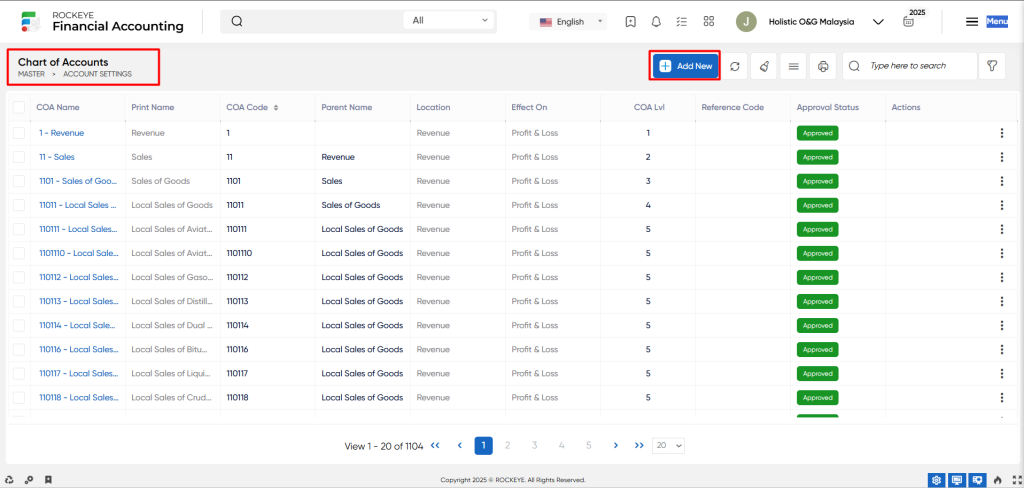Chart of Accounts
Introduction/Purpose:
A chart of Accounts is the heart of accounting that refers to a systematic listing of the various financial accounts used by an organisation to record and track its financial transactions and balances. It is a structured framework that classifies and organises financial information, enabling effective financial reporting and analysis and used for taxation reporting purposes.
Note:
This module having centrally connected fields, based on approval of the entry system will publish details to the central server and other entities are able to pull information from the central repository.
Dependency:
- Organisational structure and reporting requirements: The chart of accounts should align with the organisation’s hierarchical structure, departments, cost centres, and reporting requirements.
- Business processes and operations: The chart of accounts should be tailored to the organisation’s specific business processes and operational requirements.
- Accounting standards and regulations: The chart of accounts must adhere to relevant accounting standards and regulations applicable to the organisation’s industry and jurisdiction.
How To Navigate:
The navigation includes the following steps for viewing the chart of accounts in the Financial Accounting system

- Click on the master tab: The master can be accessed by clicking on the master tab on the side menu.
- Click on the chart of accounts: The chart of accounts can be accessed by clicking it from the account section.
Listing:
A chart of accounts listing in a Financial Accounting system is a feature which provides a list of all charts of accounts.

- Users can view the following information in the chart of accounts listing page
- Chart Of Account
- Printable Name
- Financial Code
- Parent Account name (in case of a child)
- Location (like Asset/Liability, income/expense)
- Effect on (like P&L or Balance Sheet)
- Level of COA
- Approval Status (if Approval Process / BPMN implemented)
User can perform the following actions
- Add new: The “Add new” function allows you to create and add a new chart of accounts or entries to the system.
- Refresh: The “Refresh” function retrieves the most recent data from the underlying database or source system.
- Clear cache: The “Clear cache” function clears the cached data associated with the chart of accounts.
- More options: The “More options” function provides the user with more actions or functionalities.
- Print records: The “Print records” feature allows users to print content by opening a print dialogue or displaying a preview of the content to be printed.
- Search: The “Search” function allows the user to look for a specific entry within the available data and presents the results that match the search parameters.
- Filter: The “Filter function” in the chart of accounts allows users to customise their view of the chart of accounts based on specific factors.
Recording & Update:
How To Add New Chart Of Account:

- Name: The “name” refers to the descriptive label provided to the chart of account, which clearly states the type of financial operations it represents.
- Print Name: The “Refers to an account’s name as it appears in printed financial statements or reports.”
- Definition: The “Definition” refers to a brief statement or explanation of the purpose and nature of the chart of accounts.
- Parent: The “Parent” refers to the higher-level category or grouping under which specific accounts are organised.
- Parent Code: The “Parent code” refers to the code assigned to a higher-level category or grouping in a chart of accounts (COA).
- Suffix: The “Suffix” refers to a numeric or alphanumeric character(s) added to the parent COA code to create a unique identifier for sub-accounts or child accounts within the COA hierarchy.
- COA Code: The “COA code” refers to a unique number or alphanumeric identity assigned to each account in a chart of accounts (COA).
- Location: The “Location” refers to a category or characteristic that indicates the physical or geographical location of a certain account or set of accounts.
- Effect on: The “Effect on” refers to a transaction’s impact or influence on specific accounts or financial items.
- Remark: The “Remark” refers to a note, comment, or description that is associated with a certain account.
Users can perform the following actions
- Submit: The “Submit” function allows the user to submit the required information while creating a new chart of accounts.
- Discard: The “Discard” function allows the user to cancel the submission of information provided at the time of creating a new chart of account.